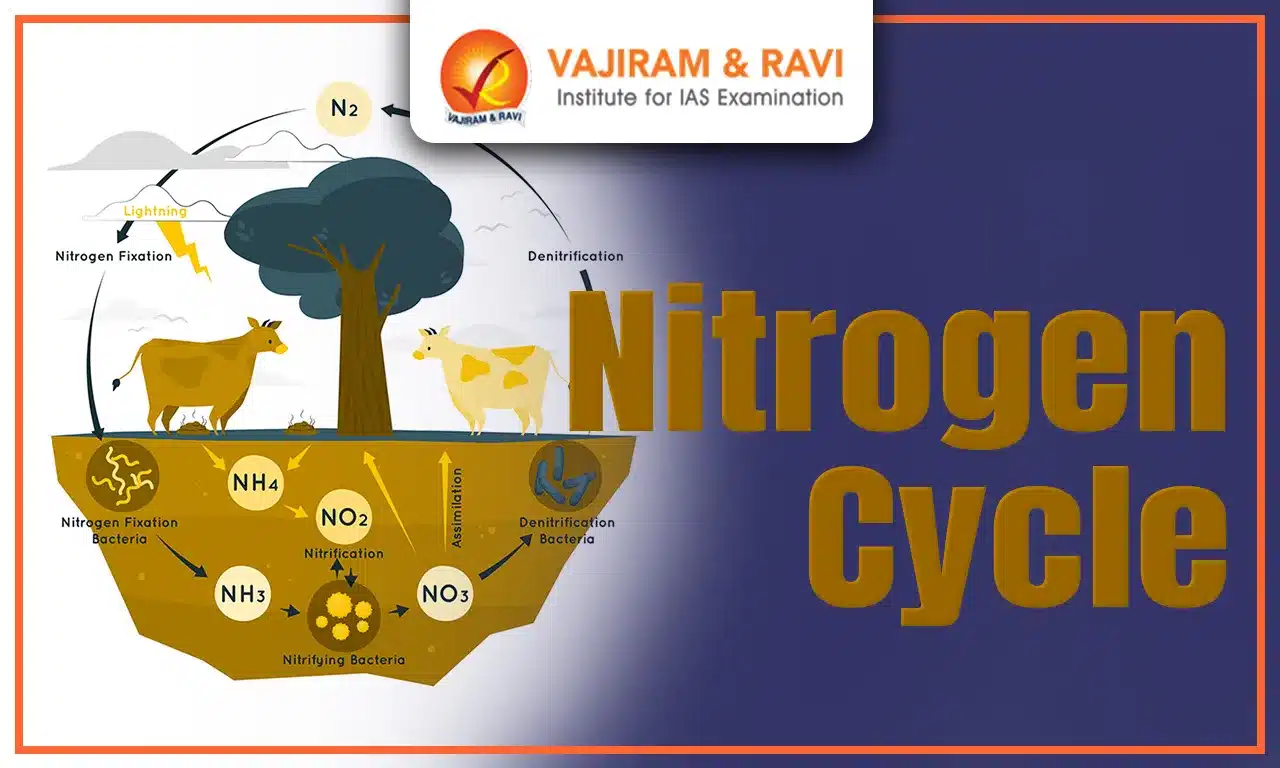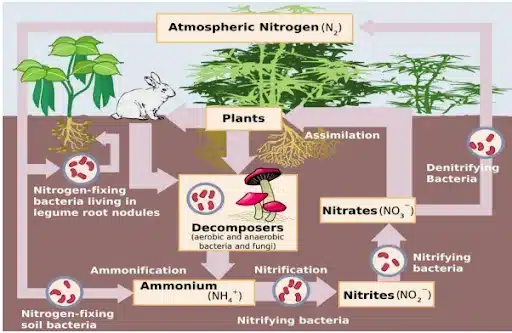Nitrogen cycle is the continuous movement of nitrogen between the atmosphere, land, and water, ensuring its availability for living organisms. It is vital for plant growth and food production, involving stages like nitrogen fixation, nitrification, assimilation, ammonification, and denitrification. Nitrogen-fixing bacteria convert atmospheric nitrogen into usable forms for plants, while nitrification and ammonification make it accessible.
Denitrification returns nitrogen to the atmosphere, maintaining ecosystem balance. However, human activities, such as the use of synthetic fertilizers, can disrupt this cycle, affecting plant health and ecosystem stability.
Nitrogen Cycle Definition
The nitrogen cycle refers to the movement of nitrogen through both land and water ecosystems, with human activities, like the use of synthetic fertilizers, affecting the process. This cycle is essential for plant growth and plays a key role in food production within the ecosystem.
Nitrogen Cycle Stages
Nitrogen Cycle Stages include key processes where nitrogen is transformed through various chemical forms. These stages are nitrogen fixation, nitrification, assimilation, ammonification, and denitrification. The detailed explanation is given below:
- Nitrogen Fixation: Lightning breaks nitrogen into nitrogen oxides or ammonia, which are then carried to the ground as nitrates.
- Nitrification: Bacteria convert ammonia into nitrites and nitrates, which plants absorb.
- Assimilation: Plants use nitrates and ammonium to produce proteins.
- Ammonification: Decomposers break down dead organisms into ammonia.
- Denitrification: Nitrates are converted back into nitrogen gas by bacteria, completing the cycle.
Nitrogen Cycle Nitrogen Fixation
Nitrogen fixation is the process of converting atmospheric nitrogen (N2) into ammonia (NH3) or other nitrogenous compounds, making it usable by plants. This occurs naturally in the soil and water through both physical and biological mechanisms. Nitrogen-fixing bacteria, such as Azotobacter and Rhizobium, play a critical role in this process. The details are given below:
Nitrogen Fixation Conditions
Nitrogen fixation converts atmospheric nitrogen (N2) into ammonia (NH3) using the enzyme nitrogenase, requiring energy, molybdenum, and iron. This process occurs in oxygen-free, nitrogen-deficient environments. The detailed explanation is given below:
- Nitrogenase Enzyme: The enzyme nitrogenase, produced by nif genes, is essential for converting molecular nitrogen (N2) into ammonia (NH3).
- Oxygen Sensitivity: Nitrogenase activity is highly sensitive to oxygen, so aerobic nitrogen-fixing organisms need mechanisms to protect them from oxygen or create an anaerobic environment.
- Energy Requirement: Nitrogen fixation requires a significant amount of energy, consuming 16 to 24 ATP molecules per N2 molecule reduced.
- Availability of Mo and Fe: Molybdenum (Mo) and Iron (Fe) are crucial components of nitrogenase, so their availability is necessary for its function.
- Absence of Fixed Nitrogen: Nitrogenase is only produced when fixed nitrogen sources, like nitrate or ammonia, are not available, ensuring fixation occurs in nitrogen-deprived environments.
Nitrogen Fixation Bacteria Types
Nitrogen-fixing bacteria can be classified into symbiotic and non-symbiotic types. Symbiotic bacteria, like Rhizobium, live in plant root nodules, while non-symbiotic bacteria, like Clostridium and Azotobacter, fix nitrogen in soil independently. The detailed explanation is given below:
- Symbiotic Bacteria: Such as Rhizobium, live in the root nodules of plants, converting atmospheric nitrogen into ammonia. This process benefits both the plant and the bacteria, as the plant receives nitrogen, and the bacteria get carbon for growth.
- Non-Symbiotic Bacteria: Like Clostridium and Azotobacter, are free-living in soil and can fix nitrogen without needing a host plant. These bacteria play a key role in the nitrogen cycle by converting nitrogen into ammonia, which can then be further processed by nitrifying bacteria into nitrites and nitrates.
Nitrogen Fixation Bacteria Importance
Nitrogen-fixing bacteria are crucial for maintaining nitrogen levels and supporting plant growth. They are responsible for 90% of nitrogen fixation, ensuring food chain stability by making nitrogen accessible to plants. The detailed explanation is given below:
- Vital for environment: Nitrogen-fixing bacteria are essential for maintaining nitrogen levels in nature.
- Nitrogen Fixation: Bacteria perform the majority of nitrogen fixation, converting atmospheric nitrogen into plant-usable forms.
- Supports plant growth: Nitrogen is a key component of proteins, and plants rely on it for healthy growth.
- Food chain stability: Without nitrogen-fixing bacteria, plants would struggle to obtain nitrogen, disrupting the entire food chain.
Nitrogen Cycle Nitrification
Nitrification is a crucial step in the nitrogen cycle, where ammonia (NH3) is converted to nitrite (NO2-) and then to nitrate (NO3-). This process is carried out aerobically by prokaryotes and involves two distinct steps performed by different microorganisms.
Nitrogen Cycle Nitrification Process
The nitrification process in the nitrogen cycle involves converting ammonia to nitrite by ammonia-oxidizing bacteria and further oxidizing nitrite to nitrate by nitrite-oxidizing bacteria. The process is explained below in detail:
- Ammonia to Nitrite: Ammonia is oxidized to nitrite by ammonia-oxidizing bacteria (e.g., Nitrosomonas, Nitrosospira). This process requires two enzymes—ammonia monooxygenase and hydroxylamine oxidoreductase. Aerobic ammonia oxidizers also fix carbon dioxide, using ammonia as their energy source.
- Nitrite to Nitrate: The second step involves nitrite oxidation, carried out by nitrite-oxidizing bacteria (e.g., Nitrospira, Nitrobacter). Like ammonia oxidizers, they use small amounts of energy to convert nitrite into nitrate.
Nitrogen Cycle Nitrification Importance
Nitrification is essential for converting ammonia, which plants cannot directly use, into nitrate, a form that plants can absorb and utilize. The process is key to maintaining nitrogen availability in ecosystems and supports the overall nitrogen cycle, which is vital for plant growth and ecosystem health.
Nitrogen Cycle Assimilation
In plants, nitrogen assimilation involves the absorption of nitrate or ammonium from the soil through root hairs. Nitrate is first reduced to nitrite and then to ammonium ions, which are incorporated into amino acids, nucleic acids, and chlorophyll.
Nitrogen Assimilation in Symbiotic Plant
Plants in symbiosis with Rhizobia bacteria assimilate nitrogen directly from the nodules in the form of ammonium ions. A more complex cycle exists where amino acids are exchanged between the plant and Rhizobia bacteroids, forming an interdependent relationship where the bacteroids pass amino acids with newly fixed nitrogen to the plant.
Nitrogen Cycle Ammonificiation
Ammonification is an important part of the nitrogen cycle, where tiny organisms like bacteria break down nitrogen-rich compounds from dead plants and animals into simpler substances like ammonia (NH3). This process helps return nitrogen to the soil in a form that plants can easily absorb, keeping the ecosystem balanced and supporting life. Some common bacteria responsible for ammonification include Bacillus, Proteus, Clostridium, Pseudomonas, and Streptomyces.
Nitrogen Cycle Ammonificiation Need
Ammonification supports plant growth by recycling nitrogen, ensuring ecosystem balance. Excessive fertilizer use, however, can disrupt this balance. The detailed explanation is given below:
- Supports Plant Growth: It provides plants with nitrogen in a form they can easily use, helping them grow and thrive.
- Ecosystem Balance: By recycling nitrogen, ammonification helps maintain the natural balance of nutrients in the environment.
- Effects of Fertilizers: Adding too much nitrogen through fertilizers can cause problems like soil toxicity or algae overgrowth, which disrupt ecosystems.
Nitrogen Cycle Denitrification
Denitrification is the biological process that converts nitrates (NO3-) into nitrogen gas (N2), removing bioavailable nitrogen from ecosystems and releasing it back into the atmosphere. The final product of denitrification is dinitrogen gas, but intermediate nitrogen forms such as nitrous oxide (N2O), a greenhouse gas, can also be produced.
- Common denitrifying bacteria include species from the genera Bacillus, Paracoccus, and Pseudomonas. These bacteria are chemoorganotrophs, meaning they require organic carbon to perform denitrification.
Denitrification Importance
Denitrification plays a crucial role in regulating nitrogen levels in ecosystems and mitigating the effects of excess nitrogen, whether in agricultural soils or wastewater systems. The detailed explanation is given below:
- Ecological Impact: Denitrification removes fixed nitrogen (nitrates) from ecosystems and returns it to the atmosphere as inert nitrogen gas (N2).
- Agriculture: In farming, the loss of nitrates through denitrification can lead to reduced fertilizer efficiency, negatively impacting crop production.
- Wastewater Treatment: In wastewater treatment, denitrification is beneficial, as it removes excess nitrates from water, reducing the risk of environmental issues like algal blooms caused by nutrient pollution.
Nitrogen Cycle Diagram
The nitrogen cycle diagram illustrates the movement of nitrogen through the atmosphere, soil, plants, animals, and bacteria. Key processes include nitrogen fixation, nitrification, ammonification, and denitrification, which together maintain nitrogen balance in ecosystems.
Nitrogen Cycle in Marine Ecosystem
The nitrogen cycle in marine ecosystems functions similarly to that in terrestrial environments but is carried out by marine bacteria. Nitrogen-containing compounds accumulate in ocean sediments and eventually form sedimentary rocks. Recent studies show that weathering of these rocks releases nitrogen, which plants can absorb.
- Marine microbes play a crucial role in driving nitrogen cycle processes like nitrogen fixation, assimilation, nitrification, and nitrogen loss.
- Ocean changes, such as warming, acidification, and deoxygenation, impact these processes and affect global greenhouse gas cycles.
Nitrogen Cycle Impact of Human Activities
Human activities, such as burning fossil fuels and extensive fertilizer use, have significantly altered the nitrogen cycle. These changes affect ecosystems by disrupting biodiversity, carbon storage, and water quality. The detailed explanation is given below:
- Nutrient Imbalance: The addition of nitrogen in terrestrial ecosystems can cause nutrient imbalances in trees, impacting forest health and biodiversity.
- Carbon Storage: Increased nitrogen availability can alter carbon storage, affecting not only the nitrogen cycle but also broader ecosystem processes.
- Leaching in Agriculture: Excess nitrogen from fertilizers leaches into soil and water bodies, contaminating streams, rivers, and drinking water sources.
- Algal Blooms: Increased nitrogen promotes harmful algal blooms, which are associated with high mortality rates in fish and shellfish populations, disrupting aquatic ecosystems and economies.
- Disease Risk: Alterations in the nitrogen cycle may raise the risk of parasitic and infectious diseases in both humans and wildlife.
Nitrogen Cycle Importance
The nitrogen cycle plays a vital role in plant growth and ecosystem health by converting atmospheric nitrogen into usable forms like nitrites and nitrates. These compounds enrich the soil, supporting plant growth and ensuring nutrient availability. Through ammonification, bacteria decompose organic matter, helping clean the environment while releasing essential nutrients into the soil.
- Additionally, nitrogen is a critical component of chlorophyll, enabling photosynthesis, which supports plant survival.
- Nitrogen is also integral to biomolecules such as proteins and amino acids, vital for the development of organisms, including humans.
- Overall, the nitrogen cycle ensures balanced nitrogen availability for ecosystems and sustainable growth.
Nitrogen Cycle UPSC PYQ
Q1. Which of the following adds/add nitrogen to the soil? (UPSC Prelims 2013)
- Excretion of urea by animals
- Burning of coal by man
- Death of vegetation
Select the correct answer using the codes given below:
(a) 1 only
(b) 2 and 3 only
(c) 1 and 3 only
(d) 1, 2 and 3
Ans: (c)
Last updated on December, 2025
→ Check out the latest UPSC Syllabus 2026 here.
→ Join Vajiram & Ravi’s Interview Guidance Programme for expert help to crack your final UPSC stage.
→ UPSC Mains Result 2025 is now out.
→ UPSC Notification 2026 is scheduled to be released on January 14, 2026.
→ UPSC Calendar 2026 is released on 15th May, 2025.
→ UPSC Prelims 2026 will be conducted on 24th May, 2026 & UPSC Mains 2026 will be conducted on 21st August 2026.
→ The UPSC Selection Process is of 3 stages-Prelims, Mains and Interview.
→ UPSC Result 2024 is released with latest UPSC Marksheet 2024. Check Now!
→ UPSC Toppers List 2024 is released now. Shakti Dubey is UPSC AIR 1 2024 Topper.
→ Also check Best IAS Coaching in Delhi
Nitrogen Cycle FAQs
Q1. What is the nitrogen cycle process?+
Q2. What is 4 in the nitrogen cycle?+
Q3. What are the 7 steps of the nitrogen cycle in order?+
Q4. What is the role of nitrogen in plants?+
Q5. What is the nitrification process?+
Tags: nitrogen cycle quest UPSC Environment and Ecology Notes


















